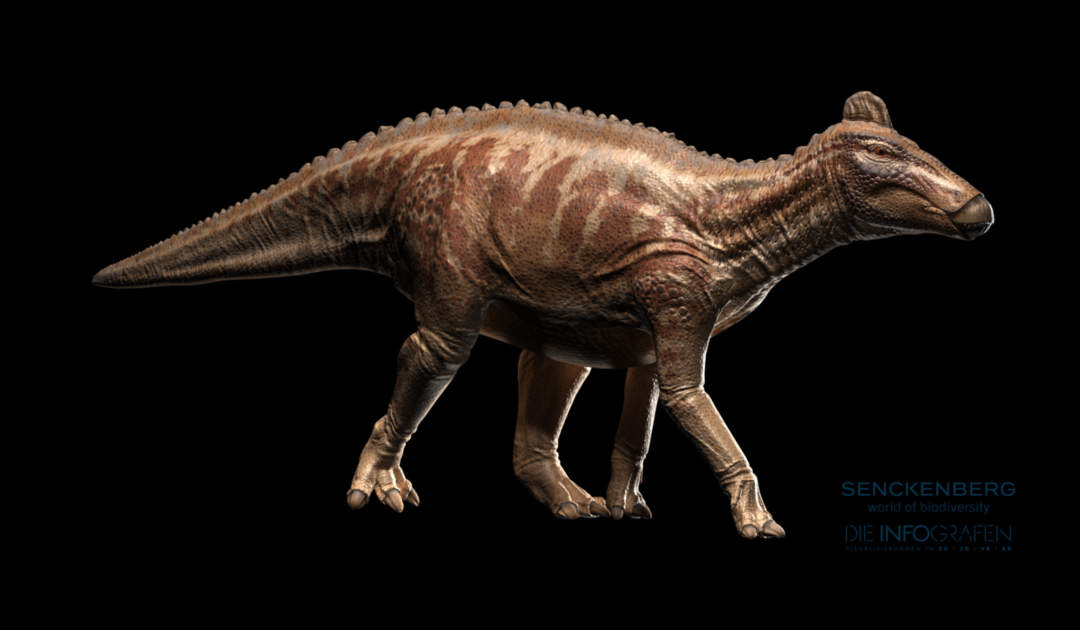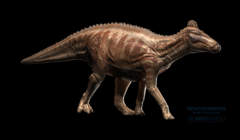Edmond’s Prehistoric Realm – A Dinosaur Excavation in Frankfurt
Special exhibition from 03 April until 25 October 2020 in the Senckenberg Natural History Museum Frankfurt
Two containers weighing 20 and 40 tons, respectively, were shipped by boat from the USA to Frankfurt. They contained “Edmond’s Prehistoric Realm” – a block of stone measuring roughly 20 square meters, chock-full of dinosaur bones. Supported by the Lipoid Foundation, Senckenberg can thus implement a globally unique project. The bone bed, retrieved from the Lance Formation in Wyoming and containing a wealth of bones from Edmontosaurus and other fossils, was transported to Frankfurt where, starting on 3 April 2020, it will be presented in a cooperative exhibition in conjunction with the Wyoming Dinosaur Center Thermopolis, the Frankfurter Kunstverein (Frankfurt Art Association), and National Geographic in the Senckenberg Natural History Museum. In front of the visitors, preparators will expose the fossils in the rock slab and prepare them for scientific analyses. The new special exhibition “Edmond’s Prehistoric Realm – A Dinosaur Excavation in Frankfurt” presents geoscientific research up close and personal.
For more than 100 years, the Senckenberg Natural History Museum in Frankfurt has been home to one of the few known Edmontosaurus mummies, nicknamed Edmond. Like the bone bed, the fossil originated from the Lance Formation in Wyoming. The almost complete skeleton and the well-preserved skin – an important reference to the dinosaur’s actual appearance – make this exhibit particularly important for science.
The analysis of the specimens from the fossil block transported to Frankfurt is intended to clarify hitherto unanswered scientific questions regarding the era of Edmond and its cohorts: What did the dinosaurs’ ecosystem in Wyoming look like during the late Cretaceous, about 70 million years ago, when the atmosphere’s CO2 concentration was significantly higher than today? How did these enormous animals live and die; who ate whom; and what challenges did they have to surmount in their daily struggle for survival, until the age of dinosaurs abruptly ended with a bang 66 million years ago?
The exhibit’s cooperative partner, the Frankfurter Kunstverein, invited the YRD.Works artist collective to design the presentation room where science can be experienced first-hand. The concept comprises three stations: the temporary building where scientists present their results; a “tapping area” where the visitors can examine rocks to discover their own fossils; and the new presentation of the Edmontosaurus mummy in the museum. In a specially constructed building designed and implemented by the artist collective, visitors will be transported into a paleontological preparation laboratory. Here, they can watch how the dinosaur bones are being processed.
In addition to the excavation circumstances, the exhibition will also showcase the bone bed’s journey from Wyoming to Frankfurt and introduce initial scientific findings gathered from the excavated fossils.
Even prior to the special exhibition’s opening in the Senckenberg Natural History Museum, you can already follow the project online. National Geographic as the exclusive media partner will periodically introduce the involved scientists, the various research methods, and details regarding the excavation, the journey, and the coming exhibition with text, photos, and moving images on the project website “Edmond’s Prehistoric Realm” at https://www.nationalgeographic.de/edmonds-urzeitreich
Main supporter: The Lipoid Foundation
A cooperative exhibition in conjunction with the Frankfurter Kunstverein, National Geographic, and the Wyoming Dinosaur Center Thermopolis.

